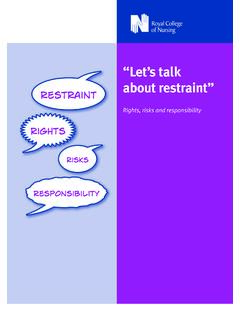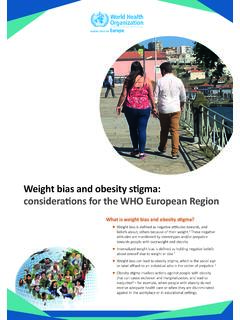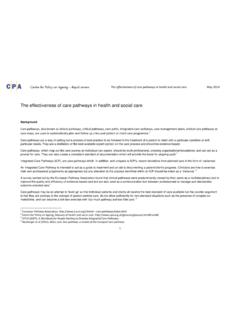Transcription of A guide to community-centered approaches for health and ...
1 A guide to community- centred approaches for health and wellbeing Full report Community- centred approaches for health and wellbeing About Public health England Public health England exists to protect and improve the nation's health and wellbeing, and reduce health inequalities. It does this through world-class science, knowledge and intelligence, advocacy, partnerships and the delivery of specialist public health services. PHE is an operationally autonomous executive agency of the Department of health . Public health England Wellington House 133-155 Waterloo Road London SE1 8UG. Tel: 020 7654 8000. Twitter: @PHE_uk Facebook: Prepared by: Professor Jane South Supported by: Jude Stansfield, Pritti Mehta and advisory group: Anne Brice, Ann Marie Connolly, Catherine Davies, Gregor Henderson, Paul Johnstone (PHE), Olivia Butterworth, Luke O'Shea, Giles Wilmore (NHS England).
2 Also Dave Buck, James Thomas, Ginny Brunton. Anne-Marie Bagnall and Kris Southby, Leeds Beckett University, undertook a scoping review for this publication. Crown copyright 2015. You may re-use this information (excluding logos) free of charge in any format or medium, under the terms of the Open Government Licence To view this licence, visit OGL or email Where we have identified any third party copyright information you will need to obtain permission from the copyright holders concerned. Any enquiries regarding this publication should be sent to Published February 2015. PHE publications gateway number: 2014711. 2. Community- centred approaches for health and wellbeing Contents About Public health England 2. Foreword 4. Executive summary 5. Introduction 7. Why work with communities? 8. Communities as building blocks for health 11.
3 A family of community- centred approaches 15. health outcomes and evidence 31. Conclusion 36. Appendix 1. How the family was developed 38. References 39. 3. Community- centred approaches for health and wellbeing Foreword There is extensive evidence that connected and empowered communities are healthy communities. Communities that are involved in decision-making about their area and the services within it, that are well networked and supportive and where neighbours look out for each other, all have a positive impact on people's health and wellbeing. Three million volunteers already make a critical contribution to the provision of health and social care in England. This is a huge asset to our nation's health . The NHS Five Year Forward View sets out how our health services need to change and argues for a new relationship with patients and communities.
4 PHE's strategy, From Evidence into Action, calls for place-based approaches that develop local solutions, drawing on all the assets and resources of an area; integrating public services and also building resilience of communities in order to improve health and wellbeing for all and to reduce health inequalities. As part of our joint commitment to community approaches and harnessing this renewable energy, NHSE and PHE have together set out what works. Through this guide we outline a family of approaches ' for evidence-based community- centred approaches to health and wellbeing. Our challenge is to create the conditions for community assets to thrive, to remove any barriers and for our services to work alongside communities in ways that are empowering, engaging and meaningful. This guide demonstrates the diversity and richness of community- centred approaches and the need to take not just one approach.
5 We hope it will stimulate partnership working and, above all, put communities at the heart of what we do. Duncan Selbie Simon Stevens Chief Executive, Public health England Chief Executive, NHS England 4. Community- centred approaches for health and wellbeing Executive summary Background Local government and the NHS have important roles in building confident and connected communities as part of efforts to improve health and reduce inequalities. The project Working with communities empowerment evidence and learning' was initiated jointly by PHE and NHS England to draw together and disseminate research and learning on community- centred approaches for health and wellbeing. This report presents the work undertaken in phase 1 of the project and provides a guide to the case for change, the key concepts, the varieties of approach that have been tried and tested and sources of evidence.
6 Why work with communities? Communities, both place-based and where people share a common identity or affinity, have a vital contribution to make to health and wellbeing. Community life, social connections and having a voice in local decisions are all factors that underpin good health , however inequalities persist and too many people experience the effects of social exclusion or lack social support. Participatory approaches directly address the marginalisation and powerlessness caused by entrenched health inequalities. Communities as building blocks for health The assets within communities, such as the skills and knowledge, social networks and community organisations, are building blocks for good health . Many people in England already contribute to community life through volunteering. Participation is also about representation, community leadership and activism.
7 There are important roles for NHS, local government and their partners in fostering community resilience and enabling individuals and communities to take more control over their health and lives. A family of approaches that work for health and wellbeing Community- centred approaches are not just community-based, they are about mobilising assets within communities, promoting equity and increasing people's control over their health and lives. A new family of community- centred approaches represents some of the available options that can be used to improve health and wellbeing, grouped around four different strands: 5. Community- centred approaches for health and wellbeing strengthening communities where approaches involve building on community capacities to take action together on health and the social determinants of health volunteer and peer roles where approaches focus on enhancing individuals'.
8 Capabilities to provide advice, information and support or organise activities around health and wellbeing in their or other communities collaborations and partnerships where approaches involve communities and local services working together at any stage of planning cycle, from identifying needs through to implementation and evaluation access to community resources where approaches connect people to community resources, practical help, group activities and volunteering opportunities to meet health needs and increase social participation health outcomes and evidence National Institute for health and Care Excellence (NICE) guidance endorses community engagement as a strategy for health improvement. There is a substantial body of evidence on community participation and empowerment and on the health benefits of volunteering.
9 The current evidence base does not fully reflect the rich diversity of community practice in England. Cost-effectiveness evidence is still limited;. nevertheless research indicates that community capacity building and volunteering bring a positive return on investment. Conclusion There is a compelling case for a shift to more person and community centred ways of working in public health and healthcare. A new family of community- centred approaches maps the range of options to achieve this shift. PHE and NHS England will continue to make evidence and learning on community engagement and development more accessible as part of efforts to mainstream good practice. Implications for local leaders, commissioners and service providers: consider how community- centred approaches that build on individual and community assets can become an essential part of local health plans recognise the scope for action as there are a diverse range of approaches that can be used to improve physical and mental health use the family of community- centred approaches as a tool to consider potential options for commissioning health improvement and preventive services involve those at risk of social exclusion in designing and delivering solutions that address inequalities in health celebrate, support and develop volunteering as the bedrock of community action apply existing evidence to the local context, but be prepared to evaluate 6.
10 Community- centred approaches for health and wellbeing Introduction The move to a new health system, including the transfer of public health to local government, has created opportunities for public health and healthcare to become more person and community centred , enabling individuals to realise their potential and to contribute to building healthier, more resilient , 2 The shifts in commissioning and practice that are starting to occur towards a whole-of-society'. approach to health need to be supported by a clear narrative setting out the case for working with communities, combined with good access to evidence and practical information. In England, a wealth of research and established models already exists, but that knowledge has not been brought together anywhere. The invaluable contributions and experiences of citizens actively involved in their own communities are rarely considered as part of the evidence base.
















